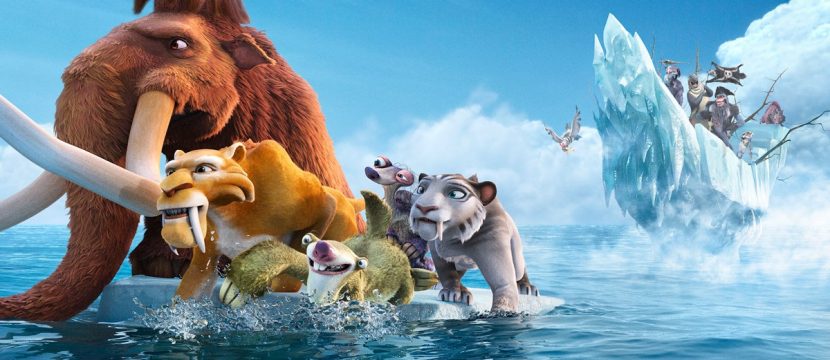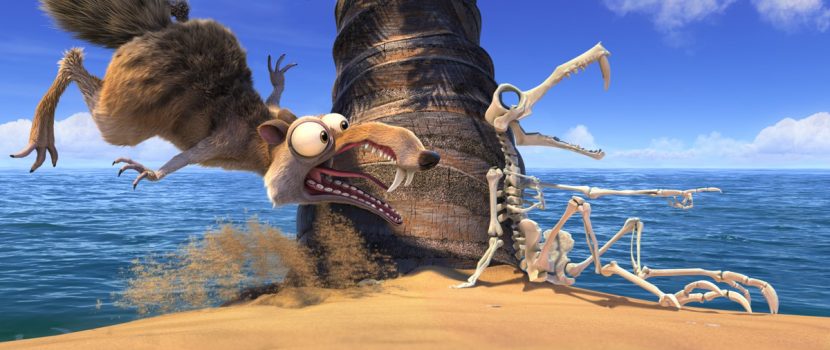It’s been ten years since Blue Sky Studios produced the first Ice Age. Now, with Continental Drift, the fourth film in the animated series, the studio has again upped the ante on its CG and rendering tools, particularly for more than 500 ocean and storm shots. We go behind the scenes with Blue Sky on water, voxels, efficient sky creation and character sims.
The motion of the ocean
The water simulations in the Steve Martino and Mike Thurmeier-directed film were the most challenging for Blue Sky, necessitated by shots of the characters stuck on an ice raft and encountering a water spout. “Some shots were easier than others, but all needed to fit within specific RAM and render time requirements established early in the film,” says Blue Sky Studios CG Supervisor Kirk Garfield. “We decided to utilize Houdini since it allowed us the most flexibility.”
A problem Blue Sky had to solve early on was how to visualize the ocean surface before it had actually been finaled. “We chose a procedural method for the ocean surfaces using the Houdini Ocean Toolkit (HOT) as a base,” says Garfield. “Using Python, we established presets for the surfaces to be visualized in Maya by the previs, camera/staging and animation departments. FX would finalize the surface at the anim stage and provide a localized patch for animation’s refinement of characters or vessels. FX would finally add splashes, secondary ripples and froth when needed.”
The look of the ocean surfaces – from calm waters to rolling waves – was referenced from other films, live footage and personal video. “The earlier departments took advantage of tools that calculated speed, velocity and other measurements,” says Garfield. “These proved to be very helpful for keeping shots consistent as well as adhering to some physical laws. It was important to get a sense of motion on the ocean without making the audience sick. We tested scenes in stereo very early to establish the camera limitations.”

The oceans were rendered with deformed polygonal meshes, an approach that was initially considered to be too memory intensive. “To deal with this challenge,” notes Garfield, “we developed a camera-dependent approach building and subdividing the ocean meshes to the camera frustum. Once the main surface was approved we would extend and close the surface in order to take advantage of scatter absorption and physically correct refractions from our in house renderer, CGI Studio.”
Visualizing Voxels
Blue Sky Studios will be presenting three sessions at SIGGRAPH 2012 on Ice: Age Continental Drift
A World of Voxels: The Volumetric Effects of Ice Age: Continental Drift
Monday, 6 August 2pm
Andrew Schneider, Trevor Thomson, Matthew Wilson, Matthew Roach
Conquering the Seas of Ice Age: Continental Drift
Tuesday, 7th August at 9am
Mark Adams, Joan Cabot, Bryan Useo, Matthew Roach, David Quirus
Making Tracks: Footprints in the Ice Age Movies
Wednesday, 8 August at 2pm
Hugo M. Ayala, Michael K. Reed, Ilan Gabai
Click here for the SIGGRAPH 2012 Talks.
For scenes of the characters meeting a water spout and riding through a storm (as well as other shots featuring destruction dust, clouds and splashes), Blue Sky developed pre- and post-simulation voxel deformers.
“Similar to the ocean/water effects,” explains Garfield, “voxel effects needed to fit within the established maximum for RAM and render time. Also, with little time to do iterative work, the effects department took advantage of advection and or procedural techniques for shaping the simulations, allowing for more art direction and less iterations.”
To deal with large voxel volumes, the Effects department at Blue Sky worked through three different approaches:
1. A tool contracted the simulation grid in areas that were either obscured by geometry or the fluid sim itself.
2. Another optimized the sim based on camera pixel size.
3. The third approach relied on improvements to Blue Sky’s voxel storage format for SMOGVOX. This is the volumetric procedure originally developed by Trevor Thomson.
Blue Sky skies
The Ice Age films have always been able to utilise incredible technology to deliver a distinctive animation style – no where is this more clearly illustrated than in the rendering of skies and clouds. These were completed as 3D sets and, according to Skies Lead Matt Wilson, have a basis in realistic sky models, but then quickly diverge and become much more painterly.
“For example,” says Wilson, “in any given sequence, time of day and sun direction are important story telling tools. If you used a tool that was 100% locked on the Preetham model (a commonly used analytic models of skylight luminance in computer graphics developed by A.J. Preetham, Peter Shirley and Brian Smits), erratic shifts in elevation and even perceptual pitch and roll of the sea-level plane would cause large shifts in overall color and solar placement. You can of course color correct the plate and make it appear in harmony with other shots, but that eats up time. What our tools do is create a complex relationship between discreet levels of atmosphere only where they effect the specific constituents in the image (solar haze, anti solar attenuation, smaug, etc.).”

“Once those are created,” adds Wilson, “you have a complete world. You can drop in the camera from any shot in a sequence and 80% of the time it takes very few tweaks to get to a final shot. It also means that there will always be a harmonious thread throughout the set, no matter which direction you look in. When you find places where the image breaks it’s extremely fast to change. For example, if you want the sun in the shot, but the camera is looking 30 degrees higher and you need 3% more turbidity overall so it perceptually matches its neighboring shots, those tweaks only take minutes. More importantly the elements change without breaking their relationship to each other, so you keep the look consistent.”
Wilson says that in addition to quickly propagating out to individual shots, “we also automatically generate other images that can be used to further incorporate the sky with our complex ray traced sets and characters. HDRI lighting environments and reflection /refraction environments that exactly match what is seen through the camera, even with shot level tweaks, are generated for every sequence in production.”
Watch a clip featuring Captain Gutt and the Ice Age characters.Blue Sky has been adopting this process since Horton Hears a Who. “The major shift with sea,” says Wilson, “is pulling forward where we are using shot level rendering of true volumetric clouds, while still running them through the sky lighting system. Similar to a pop up book, from far to near, each cloud slowly going from a pre-rendered card to its full 3D representation. The changes are subtle but in concert they allow for some amazing results. Light rays, inter cloud shadowing and non-homogeneous aerial perspective, are all elements that using more 3D rendered layers allows us. The voxel data that generates the specific cloud element is the same, but the shot level integration is upgrading as the rendering becomes fast enough.”
Since Blue Sky builds the sky world as a set rather than a flat 2D plate, only a very small team is required. There were no more than three artists on Continental Drift at any one time to create 963 unique skies, and Wilson notes that “154 of those contained 3D volumetric, raytraced clouds that seamlessly integrated with their card counterparts in the distance.”
Character sims
But it isn’t just environmental effects that Blue Sky have continued developing for the Ice Age movies. There are also some great character-related effects and sims in the film, including the shawl for Granny (a wrinkly old sloth), the beard of Captain Gutt (an orangutan) and the hair for Peaches (a teenage mammoth). These were elements handled by the Character Simulation department.

Granny’s neck, which had to hang down, was initially approached with a combination of modeling, materials and rigging, but ultimately fell to the Simulation team to provide a suitable waddle and wrinkle compression. “Collaborating with both Rigging and Modeling, the Character Simulation team came up with a great method involving a high resolution mesh sock that was used for simulating the thin skin of an elderly sloth,” explains Kirk Garfield. “To make things even more interesting, Granny wore a shawl – made of fur! This required us to develop a pipeline and toolset to accommodate the workflow between Animation, Character Simulation and Fur/Procedural Modeling.”
A similar problem to solve came in the form of blubbery seal Flynn, whose body needed to jiggle in order to show his underlying layer of fat. “A character simulation rig was designed to allow animator to work with a fast, optimized rig,” says character simulation supervisor Keith Stichweh, “and then utilize a simulation to add the high-frequency ripples that occur on seal blubber as they propel themselves and collide with their environment.”
And Blue Sky’s next level of animation and effects work will be seen in Epic, directed by Chris Wedge and to be released in 2013.
All images and clips © 2012 Twentieth Century Fox Film Corporation.

Pingback: Minecraft è l’ultima vera avanguardia? | CreatoridiFuturo.it